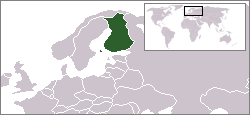Cookbook:Cuisine of Finland
Cookbook | Ingredients | Cuisines | European cuisines

Finnish cuisine is generally healthy, thanks in part to wholemeal products (rye, barley, oats) and berries (such as blueberries, lingonberries, cloudberries, and sea buckthorn). Traditionally families gather berries from forests in the autumn. Various turnips were common in older cooking, but these were largely supplanted by the potato when it was introduced in the 18th century.
The Finnish cuisine combines traditional country fare and upper-class cuisine with modern continental style cooking. Spices have been adopted from West and East. Finnish cuisine is pleasing to the eye and the taste buds and has something special for every month of the year.
Fish and meat play a prominent role in any traditional Finnish dish, vegetarianism being historically non-existent.
In the new Finnish kitchen, dishes are lighter, smaller and generally contains several different vegetables. This mode of cooking is highly influenced by European and American cuisine.
Introduction from Wikipedia.
Finnish dishes
edit- Baltic herring – silakka
- Joulupöytä – Christmas board
- Erikoiskeksit – Special Cookies
- Kaalikääryleet – cabbage rolls
- Kalakukko
- Karjalanpaisti – Karelian stew
- Karjalanpiirakat – Karelian pastries
- Mashed potato - perunamuusi
- Meatballs (possibly originally from Swedish meatballs) - lihapullat
- Mustamakkara – blood sausage
- Pea soup - hernekeitto
- Pepu
- Pottilohko
- Reindeer stew - poronkäristys
- Rusupiirakka
- Salmon – lohi
- Särä
Bread
edit- Ruisleipä – Rye bread
- Maitorieska – milk azyme
Drinks
editDesserts
edit- Mämmi
- Golden cloudberry dessert
- Tippaleipä – variant of funnel cake eaten during the 1st of May celebrations
- Vappumunkki – sugar covered donut eaten during the 1st of May celebrations